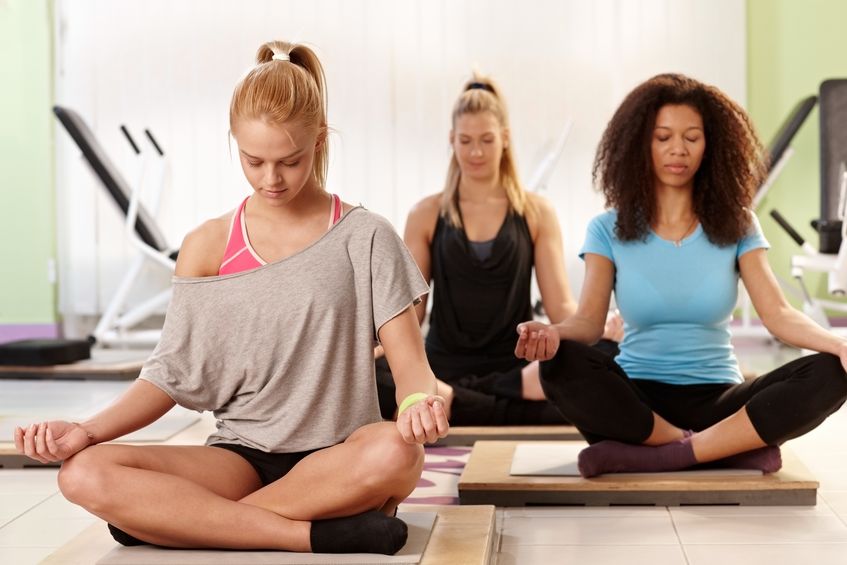How to Meditate for Daily Growth, Self-Care, and More Stress-Free Days at the Office
Why would any businesswoman find useful a practice espoused by Paul McCartney, Tracee Ellis Ross (daughter of Diana Ross, and star of TV’s Black-ish), and Kenneth Branagh, known for his great Shakespearian performances and as the director of the blockbuster movies Thor and Cinderella?
They are all devotees of meditation, and the answer to the above is simple: because the same focus, refusal to get caught up in destructive emotions, and ability to re-boot the brain’s often overworked circuitry can be just as valuable for people in the corporate world as for rock stars and actors. In fact, this year Forbes devoted an article to “7 Ways Meditation Can Actually Change the Brain,” noting that research has found that it not only improves concentration and attention span, but may also alter the brain’s neurology (in other words, without surgery or drugs, you have the tools to give your brain a makeover!). Forbes also published an article on how just short episodes of focused mindfulness training can have a lasting effect on reducing stress, that seemingly daily staple of business life.
Unfortunately, balancing demanding personal and professional lives, without a break to reboot and recoup can lead to an increase in negative emotions such as guilt, shame, obligation, exhaustion, and fear. These toxic emotions cause self-doubt and separation and thus pull individuals further from their path of prosperity. Leading a successful life, requires a balance of work and rest – mental and physical. Meditation offers a tool for self-reflection and personal empowerment.
Meditation: An Introduction
First of all, meditation has a lot of preconceived branding. One myth is that you have to buy into an Eastern philosophy or religion to properly meditate. There are philosophies that tie in with meditation, but for the most part, the practice is solely concerned with centering your mind and finding a place of peace in a chaotic atmosphere.
Another myth is that there is a proper way to meditate. A lot of people believe that you need to be sitting in a Zen garden, with a few monks, and your legs crossed, and remain perfectly silent for three to six hours. Although this is certainly one way to meditate, the bare bones of the practice is to connect you to a deeper sense of yourself. This requires nothing but you, a little time, and a desire to find peace within.
Types of Meditation
The three practices that can bring us to a place of empowerment are: Mindfulness, Visualization, and Affirmational (or Feeling) meditations.
Mindfulness
Mindfulness meditation is simply becoming aware of the present moment. Feeling your feet planted on the ground, expanding your peripheral vision to include all of your surroundings, or breathing deeply contribute to bringing yourself out of your thought patterns and into the peace of the moment.
Visualization
Visualization meditation requires an envisioned narrative: one of your body filling with light, rhythmic ocean waves, or maybe a car slowing down as a metaphor for slowing down the mind. The story is dependent on what relaxes the individual. Visualization is synonymous to the cliché, “the power of the mind;” our energy can shift instantly if we imagine uplifting and restorative narratives. We see what we believe.
Affirmation/Feeling
Affirmation and Feeling are probably the best for incorporating empowerment into everyday life. Sitting still and focusing on what you are feeling, allowing that feeling to be, and switching your focus to powerfully positive thoughts shifts your energy in no time at all.
Next, Posture, Breath, and Stillness are three components of a simple meditation. These components will ensure an active mediation, where you are alert but relaxed, and open up a space for a renewed energy.
Key Components of Meditation Practice
Posture
- Sit comfortably. Often this is with our legs crossed, but sometimes we can plant our feet to feel grounded and connected to the earth. Comfort in sitting ensures comfort in your meditation.
- Hands facing upward. No matter where they are placed, this again connects you to energy around you, allowing yourself to become open to mental shifts.
- Align to feel alert. Sitting with a straight spine is best. If you are falling asleep, you won’t experience an active meditation.
Breath
Take a deep, consistent cycle of breath. It has been scientifically proven that deep breathing helps to calm our sympathetic nervous system (that’s not the aspect that makes you feel badly for a friend, but rather the body’s ability to regulate many complex functions). By getting a good oxygen flow, we can create a flow between our bodies, minds, and spirits.
To relax into your meditation, sometimes you can breathe in, breathe out. Even count by multiples – e.g., 3, 6, 9, 12, etc.
Stillness
What to meditate on: A word that has a positive association. “Love,” “hope,” and “healing” are some good ones.
A visualization is also excellent for a recharge. For instance, envisioning that the body is slowly covered in beautiful golden light cleanses energy and restores vitality. Sit with a focus on one of these, and watch miracles happen.
Doubts About Meditation?
“But I can’t get my mind to turn off. I can’t sit still. I won’t be able to do it.” — This claim is among the biggest myths of meditation. Meditation may not seem easy, but the key is to not resist the thoughts that come. When a thought rises to the surface, escort the mind back to a mantra or a visualization.
Do not focus on becoming a master – instead, love every fault, flounder, or insecurity that you encounter, since that opens a space to transcend to empowerment.
Fear of not having “a perfect meditation” experience is like a fear that stems from a pressure to be our best selves at all times, a pressure that we as individuals do not create. Sit in loving stillness and challenge that pressure, challenge every feeling of failure, and challenge your heart to love yourself. The result is simple: step into meditation, and you step into your power.
18 Interviewer Interview Prep
Interviewer Interview Prep Impactful Mentees
Impactful Mentees Benefits of a Mentor
Benefits of a Mentor Advice for First-Time Managers
Advice for First-Time Managers Overcoming the 18-month Itch
Overcoming the 18-month Itch Dressing for Your Style
Dressing for Your Style Interview Style Tips
Interview Style Tips Women's Stocking Stuffers
Women's Stocking Stuffers Gift the Busy Traveler
Gift the Busy Traveler Father’s Day Gift Guide
Father’s Day Gift Guide Airport Layover Activities
Airport Layover Activities Traveling & Eating Healthy
Traveling & Eating Healthy Travel Like a Boss Lady
Travel Like a Boss Lady The Dual California Life
The Dual California Life Gifts for Thanksgiving
Gifts for Thanksgiving Summer Reading List
Summer Reading List Top Leisurely Reads
Top Leisurely Reads New Year, New Books
New Year, New Books Life Lessons from a Sitcom
Life Lessons from a Sitcom Oprah, Amy or Amal?
Oprah, Amy or Amal?






